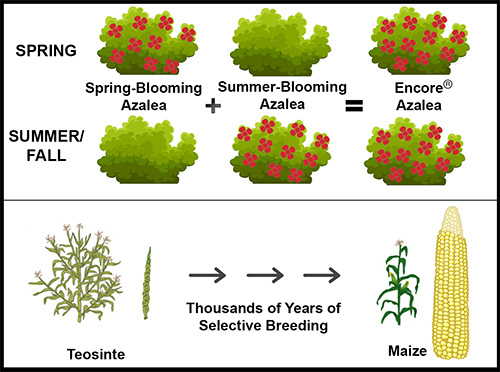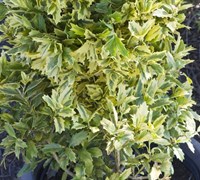Genetic Engineering with Plants
The term “genetic engineering” has garnered a lot of bad press lately, but humans have been tinkering with the genetics of plants for thousands of years. Every plant (such as the azalea) which has hundreds (if not thousands) of cultivated varieties has been “genetically engineered” by man, and as such, is technically (and literally) a genetically-modified organism (GMO). Here's a little background. A gene is a set of instructions in the DNA for the plants (or any organism for that matter) to make a certain product, usually a protein like an enzyme, that affects the way the plant looks and behaves. With genetic engineering, genes from one species of plant are mixed with genes from another species. This mixing produces a new variety of plant with different characteristics.
Let’s take a look at the Encore variety of azaleas featured in this month’s newsletter as an example. A plant breeder (Robert E. “Buddy” Lee) crossed a spring-blooming azalea with a summer-blooming azalea to produce the Encore Azalea, a flowering shrub that blooms twice a year (once in the spring and again in the late summer and into the fall). Essentially, the gene responsible for early blooming was mixed with a different gene responsible for late blooming and placed into the same plant – the Encore Azalea – resulting in multiple blooming periods throughout the year.
Most of our food crops have also been altered over time. A good example is corn (maize). About 4,000 years ago humans began selectively breeding descendants of the Teosinte plant to produce the corn that we know and love today. When you compare today’s maize plants with the teosinte grass, there is not much similarity in outward appearance. But thanks to human tinkering, there is now about a five gene difference between the two plants, and those five genes make all the difference.
These traditional methods of genetic engineering take many years and often involve many genes. Today’s laboratory-based methods of genetic engineering are more precise, faster, and usually involve manually moving only one gene from one organism to another. The term “GMO” (as you have probably heard it) is typically used in reference to organisms that have been engineered to contain genes from a different organism that would not be possible by traditional breeding. For example, a gene from a bacteria was inserted into corn in order to make it resistant to specific pests (in this case, the corn borer) and reduce the need for pesticides (this new plant variety is called Bt-corn or Bt-maize). Plants and bacteria don’t normally breed with each other, so this is a result that would not have been possible with traditional selective breeding. But remember that a gene is a set of instructions for making a protein. The gene from the bacteria allows the corn plant to produce a protein that is toxic to the corn borer but not to other organisms (and not to humans). Our bodies break down this protein in our stomachs as we do with other proteins. The protein kills corn borers by binding to a specific receptor they have on their epithelial cells (a receptor that humans don’t have). Without the receptor, the protein is not toxic.
The purpose of this article is not to debate the merits and hazards of selective breeding over time with faster laboratory genetic modification. Both methods have resulted in plant strains that offer additional benefits to humans. And I’m sure that both methods have in the past, or will in the future, produce “dangerous” plants. In fact, a potato that was selectively bred through traditional methods to have a higher sugar and starch content ended up containing poisonous compounds that resulted in its eventual recall (Lenape potato). A lot of scientists would argue that there is more danger with conventional breeding methods because they change many genes at once, whereas laboratory methods are focused on only a single gene. So when something does go wrong, it’s far easier to figure out the cause with laboratory breeding than with traditional selective breeding. The bottom is line is that humans have always tinkered with the genetics of plants, and I predict that we will continue to tinker with these genetics one way or another for many more years to come.






















